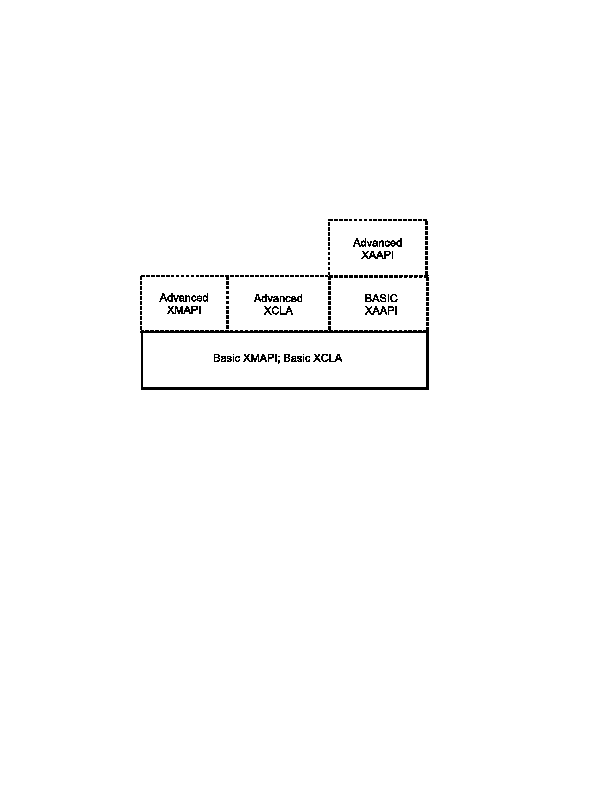Previous section.
Systems Management: Software License Use Management (XSLM)
Copyright © 1999 The Open Group
Function Sets and Functional Towers
XSLM functionality is described in terms of a set of
Base Function
and
one or more optional
Function Towers.
Function Towers provide for the
optional extensions in licensing system functionality while retaining
consistency across all licensing systems that implement the same
function towers.
The Base Function set is a prerequisite for all function towers. That
is, the Base Function set must be present before any optional function
tower may be implemented. Each Function Tower offers a complete set of
functions; that is, if one function of the Tower is implemented, then
all functions defined as being part of that same Tower must also be
implemented.
Currently Defined Functional Towers
The relationship between the Base Function set and the Functional
Towers is depicted in
Base Function Set and Functional Towers.
The current level of the XSLM
specification defines four Functional Towers:
-
Advanced Management API (Advanced XMAPI) tower
-
Basic Application API (Basic XAAPI) tower
-
Advanced Application API (Advanced XAAPI) tower
-
Advanced License Certificate Architecture (Advanced XLCA) tower.
 Figure: Base Function Set and Functional Towers
Figure: Base Function Set and Functional Towers
Base Function Set
The
Base Function
set consists of two elements:
-
A common License
Certificate Architecture (XLCA)
-
A standard set of management
application programming interfaces (referred to as the XMAPI function
set).
The common License Certificate (data) Architecture provides the
capability to fully encode application license terms and conditions in
the form of an architected (standardized) license certificate that may
be installed into any XSLM-compliant licensing system that supports the
embedded certificate data elements. These certificates may be
subsequently managed and/or interpreted by any compliant management
application. The XLCA is also used to define license certificate meta
data (for example, usage measures) and optionally, licensing system
specific certificate data elements.
The XMAPI defines the set of
programming interfaces necessary to build licensing system management
tools capable of managing (installing, removing, etc.) standardized
license certificates and/or providing comprehensive application license
usage reports.
The XAAPI defines the set of programming interfaces
(API functions) necessary to enable for license management those
applications that run in trusted environments. A trusted environment
is, in this context, one which is by design physically secured, or
through hardware and/or software services protects programs and data
from unauthorized alteration. (The Base Function set does not include
the XAAPI).
Advanced Function Towers
The
Advanced Application API
Function Tower adds a set of services
intended to provide more comprehensive protection (with respect to
licensing) and flexibility for application publishers, particularly for
those applications that run in untrusted operating environments.
Function-Related Management API Functions
Management applications must have the ability to determine the set of
XLCA defined data elements, as well as the APIs, supported by the
license servers that comprise a customer's licensing system. The
xslm_query_server_info()
function is defined to satisfy this
requirement.
This function facilitates processing of licensing data
provided by Legacy Functional Level license servers; servers which may,
at the discretion of the implementor, elect to limit support to a
proper subset of XLCA-defined certificate data (and meta data) elements
and logged data.
Legacy Functional Level (Level 0)
This functional level is intended to provide a transition path to the
standard compliance level (or higher) for existing licensing systems;
specifically, the ability to respond to a subset of XMAPI functions
(the ones querying certificate and logged data), returning a
semantically correct subset of XLCA-defined (the Basic XLCA set)
certificate data elements and a semantically correct subset of logged
data.
To support Legacy Functional Level a licensing system must
implement the following XMAPI functions (the Basic XMAPI set):
-
-
xslm_get_certificate()
xslm_query_cert_ids()
xslm_query_next_level_cert_names()
xslm_query_servers()
xslm_get_license_instances()
xslm_get_logged_data()
Why not acquire a nicely bound hard copy?
Click here to return to the publication details or order a copy
of this publication.

